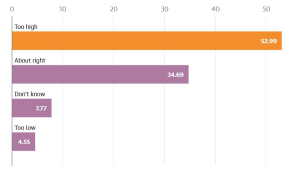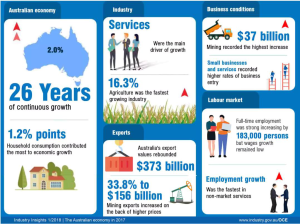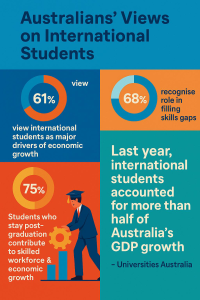The impending 2026 election will mark the heating of the immigration debate in
Australia. An interesting paradox was revealed in the study conducted at Australian National
University (ANU) and shared by The Guardian: while 50% of Australians want less migration,
most of them are against reducing international student numbers, who contribute billions of
dollars to the Australian economy. This contradiction highlights how public perception is in
discord with economic reality. Politicians like Peter Dutton demand a reduction in permanent
migration, citing easing pressures on housing, yet such broad policies paint a negative image of
Australia’s economic growth and cultural diversity. Migration, when strategically managed, is a
cornerstone of national progress. The design and implementation of misguided migration
reduction will hold Australia economically and socially back.
The Public’s Misinformed Pulse

Figure 1: A Majority of Australians Surveyed by ANU Think Immigration is Too High (Nicholas, 2025)
The ANU survey, which involved over 5,000 respondents, reveals the widespread
misconceptions about migration. Australians overestimate the proportion of international2
students, thinking they constitute 38% of working-age migrants, whereas the 2016 Census shows
it is only 20%. This finding aligns with that of Nicholas (2025) that most Australians perceive
immigration as too high. Dr. Suker Amato, an ANU migration researcher who was interviewed,
explains, “When people are given accurate data, like the economic contributions of students,
support for migration would increase considerably. On the other hand, bad press causes a loss of
support, for example, housing cost issues, and this shows how volatile public opinion is and how
much it depends on the way issues are framed.”

Figure 2: Impact of Migration to Australia as of 2018
Australians’ concern is not with migrants alone; rather, the fear lies with the strain on
infrastructure. International students are of public benefit because of their economic
contributions. However, permanent or humanitarian migrants are treated differently and
considered more critically and harshly. For instance, the ANU study found 40% of respondents
supported maintaining or increasing student numbers, compared to lower approval for other
migrant groups. This selective acceptance suggests a public open to specific policy, not blanket3
restrictions. Yet, political rhetoric often exploits these misconceptions, amplifying fears rather
than addressing them.
The Economic Engine of Migration
International students are a cornerstone of Australia’s economy. In 2023, they injected
tens of billions, supporting universities, local businesses, and jobs in education, hospitality, and
retail. Beyond immediate revenue, many students transition to skilled migrants, filling critical
workforce gaps. In 2025, at least 70% of migrant graduates will remain to work in Australia
(Martin, 2024). Dr. Amato notes that students are a long-term investment because they study,
work, and often stay, addressing skill shortages that domestic graduates cannot fully meet.

Figure 3: Views on the Impact of International Student Population on Australia (Data Obtained from Martin (2024)
Cutting student numbers would have some domino effects. Universities, which rely on
international fees, could face budget shortfalls, leading to program cuts that affect domestic
students. The flow-on impact would hit local economies, from cafes near campuses to rental
markets. Skilled migration, too, is vital. Australia competes globally for talent; restrictive4
policies could drive professionals to Canada or the UK, where immigration systems are more
welcoming. In The Guardian, Nicholas (2025) notes that the link between migration and housing
costs is “less clear-cut” than politicians claim, with net migration still below pre-COVID
projections. This suggests migration’s economic benefits far outweigh its perceived drawbacks.
The Housing Crisis Misdiagnosis
Politicians like Dutton argue that migration fuels housing unaffordability, but this
narrative oversimplifies a structural crisis. Zoning laws, speculative investment, and slow
construction approvals drive price surges more than migrant inflows. For instance, Alyssa Leng,
a research officer at the Development Policy Centre, is cited in the Guardian article as having
reported that even with a hike in median house prices, migrant numbers were steady. Politicians
take an easier route by blaming migration rather than tackling the real cause. The rhetoric may
also work against international students, whose fees help offset the cost of domestic education.
Fewer students enrolling could mean that universities either increase fees for domestic students
or cut courses, which is detrimental to all students. Dr. Amato warns that targeting migrants for
housing issues is like treating a fever with a bandage – it does not address the underlying problem.
Real solutions should include increasing housing supply, changing zoning, and checking investor
speculation. Migration cuts offer temporary relief at the expense of economic growth.
The Political Stakes
The immigration debate is a part of election battleground. Dutton’s pledge to cut
permanent migration leverages public anxiety around housing and infrastructure. The Labor
government is also planning to cut down net migration this financial year, indicating pressure
from both sides (Nicholas, 2025). Yet, the ANU survey shows that public opinion is not cast in
stone – the facts can shift public attitudes. Support for migration could rise when migrants, like5
foreign laborers, boost housing. This hints that a politician has a duty to inform instead of
inflaming. Broad-scale migration cuts carry risks associated with politics. Dissuading
international students could tarnish Australia’s image in terms of education, with subsequent
disrepute being inflicted on tourism and trade.
A Smarter Policy Framework
Australia needs an immigration system that works transparently, is data-driven, and operates
strategically. Retaining international students
and skilled migrants remains a non-
negotiable proposition for economic stability.
At the same time, in the area of housing,
governments need to work towards
increasing supply and restricting speculation.
Public communication is of paramount
importance. When myths are combated with facts, the prevailing attitudes can indeed change, as
the ANU study highlighted. In this spirit, multimedia tools can be harnessed. Included in this
commentary is an infographic showing migrant student contributions and another one showing
the impact of migration on Australia in general. The blog hosts a poll asking whether Australia
should prioritize student migration to urge readers to join in on the conversation. Public
communication is critical: countering myths with facts can reshape attitudes, as the ANU study
demonstrates. Multimedia tools amplify this effort.
Overall, Australia’s future depends on smart migration policy. The ANU study reveals a
public open to persuasion and not one glued to anti-migrant sentiment. Broad migration cuts may
score political points, but they threaten economic and social gains.
HYPOTHETICAL X POST FROM
@ANUPOLICY
X post text:
int’l students drive $50b to Aus
economy & fill skills gaps, yet caps
threaten 14,000 jobs. 61% of voters
see their value! #migrationmatters
#highered6
Tailoring policies to types and tackling housing’s structural causes could help Australia harness migration’s
strengths. Limiting immigration carelessly could stall Australia’s progress—embracing it wisely
will ensure a prosperous, inclusive future.
References
Nicholas, J. (2025, February 4). Australians want less migration but oppose cutting international
student numbers, study finds. The Guardian. https://www.theguardian.com/australia-
news/2025/feb/04/australians-want-less-migration-but-oppose-cutting-international-
student-numbers-study-finds
Martin, K. (2024, August 23). Australia: Voters view international students as drivers of
economy. The PIE News. https://thepienews.com/australia-voters-view-intl-students-as-
drivers-of-
economy/#:~:text=“The%20sector%20is%20worth%20almost,face%20of%20declining%
20government%20funding.”

Be the first to comment